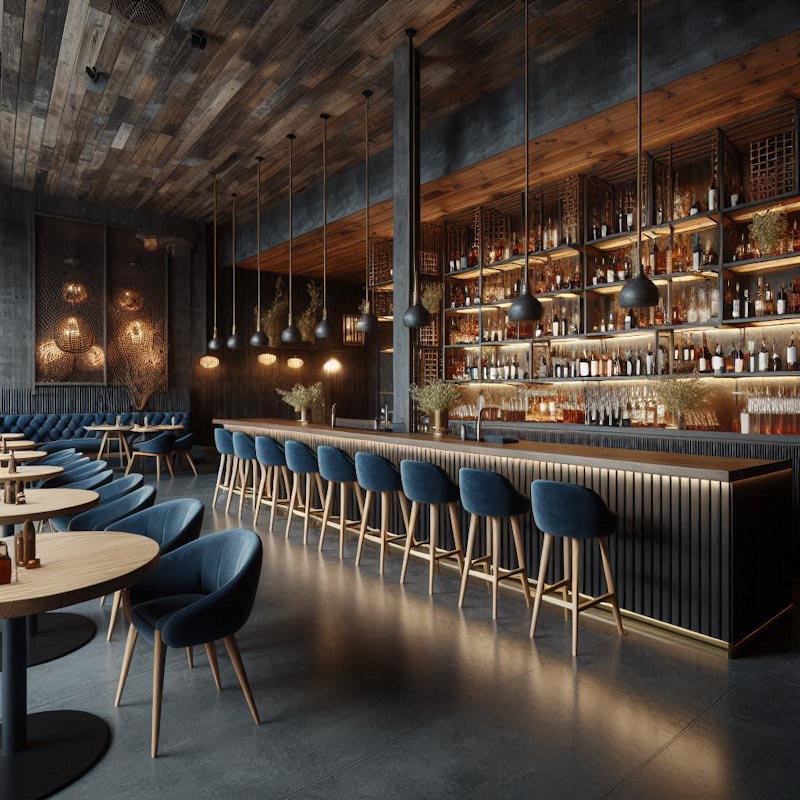
2025 Vision: Adapting Restaurant Design with Customer Needs and Evolving Technology
By Joemy Vega
As we approach 2025, restaurant design is undergoing a transformation. Customers expect more than just great food, they want dining experiences that align with their lifestyles, values, and needs. To stay competitive, restaurants must embrace customer-first design while integrating strategic technology and adaptable layouts that meet modern demands.
Here’s how restaurants can prepare for the future with thoughtful, scalable design strategies that prioritize their customers and position them for long-term success.
Customer-First Design: Building Experiences That Resonate
At the heart of every successful restaurant is a space that speaks to its customers. Today’s customers seek more than a meal, they want environments that feel personal and adaptable. Whether it’s modular seating for group gatherings, quiet nooks for solo diners or remote workers, or streamlined layouts for on-the-go customers, restaurant design must be intentional and versatile.
Designing for flexibility ensures that a restaurant remains relevant throughout the day. Multi-functional spaces allow for smooth transitions—from a vibrant breakfast spot to an intimate evening setting. Thoughtful details like biophilic design (greenery), environmental graphics, curated music programs, and lighting schemes enhance the atmosphere, creating memorable customer experiences.
Consistency across every element from signage and uniforms to tableware and scent strategies, reinforces a brand’s identity. This creates an immersive experience that resonates with customers and strengthens their connection to the brand.
Adapting Layouts for Convenience and Growth
Modern dining behaviors have reshaped the way restaurants use their spaces. Traditional layouts, which once maximized seating and relegated other functions to smaller back-of-house areas, no longer meet the growing demand for delivery, grab-and-go, and other convenience-focused options. Restaurants must rethink their layouts to incorporate dedicated zones for packaging, order pickup, and streamlined workflows.
These adjustments improve operational efficiency, enhance accessibility from the exterior, and create separate pathways for fast in-and-out pickup, reducing congestion at the main entrance. Not only do these changes optimize flow, but they also create a smoother, more satisfying experience for customers. Updating layouts is no longer optional—it’s essential to meet the needs of today’s fast-moving world.
For example, Hillstone Restaurant Group (e.g., Houston’s) has reworked layouts in select locations to include designated parking and discreet pickup areas, offering a seamless takeout experience while maintaining their polished, customer-focused atmosphere. Similarly, Chipotle has introduced digital kitchens with separate pickup entrances and shelves for online orders, catering to delivery drivers and customers without disrupting the dine-in experience.
The Role of Technology: Supporting Human-Centered Experiences
While design takes center stage, technology enhances and supports the restaurant experience. Artificial intelligence (AI), for example, has revolutionized both operations and customer interactions. AI helps streamline processes like inventory management, staffing, and order predictions, reducing waste and improving efficiency.
For customers, technology like augmented reality (AR) menus and AI-powered chatbots enhances personalization and convenience. Customers can view 3D visualizations of menu items or receive tailored recommendations based on their preferences, creating a more engaging and interactive experience.
It’s important to note, however, that technology should enhance—not replace—the human connection that makes dining special. Strategic implementation of these tools should complement, not overshadow, the design and customer experience.
Franchise-Ready Design for Scalable Success
For restaurants looking to expand, franchise-ready design systems are critical. Detailed style guides, scalable prototypes, and vendor partnerships help maintain brand consistency across multiple locations while allowing for localized adaptations. These systems ensure a brand remains recognizable and impactful, no matter where it’s located—whether in an airport, stadium, or urban center.
More than ever, old-school layouts are being replaced with strategic designs that prioritize functionality, flexibility, and brand consistency. Restaurants that adapt to these changes are better equipped to meet customer needs and remain competitive in today’s dynamic market.
2025 and Beyond: Setting the Standard for Restaurant Design
As we move closer to 2025, the restaurant industry’s evolution shows no signs of slowing down. Brands that focus on customer-first interiors, flexible layouts, and smart technology will lead the way in delivering exceptional experiences.
Successful restaurants will be those that adapt not just to trends, but to the ever-changing needs of their customers. By crafting thoughtful environments and leveraging technology strategically, restaurants can create experiences that leave a lasting impression and drive both loyalty and growth.
About the Author
Joemy Vega is the Founder and VP of Design at DV Studio in Orlando. We are a hospitality design firm specializing in restaurant interiors. DV Studio, team creates immersive, brand-driven ecosystems that include interiors, environmental graphics, uniform design, sensory programs, and procurement.
Joemy Vega/DV Studio Founder/Design VP
255 S. Orange Avenue St 104
Orlando, FL 32801
407.630.7308 – Office
407.496.3288 – Cell
www.dv-studio.net info@dv-studio.net
To read more great articles you can use, visit www.trnusa.com





Recent Comments